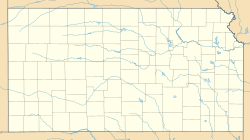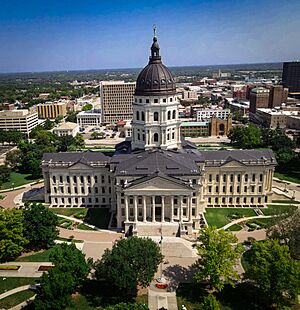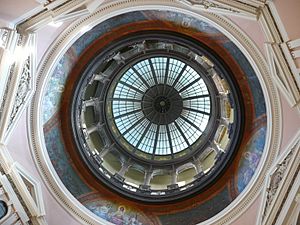Kansas State Capitol facts for kids
Quick facts for kids |
|
|
Kansas State Capitol
|
|
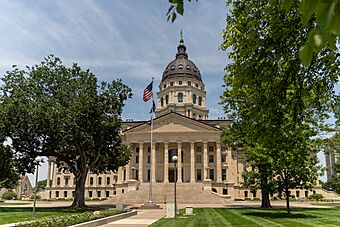
The Statehouse, in 2024
|
|
| Location | SW 8th & SW Van Buren, Topeka, Kansas |
|---|---|
| Area | 20 acres (8.1 ha) |
| Built | 1866–1903 |
| Architect | E. Townsend Mix |
| Architectural style | French Renaissance |
| NRHP reference No. | 71000330 |
| Added to NRHP | September 3, 1971 |
The Kansas State Capitol, also known as the Kansas Statehouse, is a very important building in Topeka, Kansas. It's where the main government offices for the state of Kansas are located. This includes the Governor and the lawmakers who create new rules and laws for the state. Topeka has been the capital city of Kansas since 1861, when Kansas became a state.
The Capitol building has a tall dome that reaches 304 ft (93 m) into the sky. This makes it taller than the dome of the United States Capitol in Washington, D.C.! You can even take a special tour to the very top of the dome. To get there, visitors climb 296 steps from the fifth floor. It's one of the few state capitols that offers such a unique experience.
Contents
History of the Kansas State Capitol
Building the Capitol: The Early Years
The land for the Capitol building was given by Cyrus K. Holliday in 1862. He was a key person in founding Topeka. The main architect for the building was Edward Townsend Mix. Other architects, like John G. Haskell, designed parts of it.
Construction started in 1866 on the East Wing. Workers used special limestone from Geary County, Kansas, for this part. Then, in 1879, work began on the West Wing, using limestone from Cottonwood Falls, Kansas. In 1881, the state decided to build a central part to connect the two wings. The dome, which is a famous part of the building, began construction in 1889.
Completing the Capitol and Adding Art
The Kansas State Capitol was officially finished in 1903. It took 37 years to build!
Many years later, in 1988, a design for a sculpture to sit on top of the dome was finally chosen. This sculpture is called Ad Astra. It's a large bronze statue, about 22+2⁄12-foot (6.8 m) tall and weighing 4,420 pounds (2,000 kg). It was placed on the dome on October 10, 2002. The artist, Richard Bergen, created the sculpture to show a Kansa Native American aiming a bow and arrow at the North Star. The name "Ad Astra" is Latin and comes from Kansas's state motto, "Ad Astra Per Aspera," which means "To the stars through difficulty."
Modern Updates and Features
The Capitol building has been featured on Kansas license plates several times. The dome and the "Ad Astra" statue are on the standard license plate design that started in August 2024.
In December 2001, the Statehouse began a big project to modernize and restore it. This project cost a lot of money and finished in the spring of 2014. The updates included new heating and cooling systems, better security, and easier access to restrooms. They also added a new parking garage, a visitor center, and underground office space. The roof and dome were also repaired.
Art Inside the Capitol: Murals and Frescos
The Capitol building is home to many beautiful artworks, including frescos and murals.
In 1898, an artist named Jerome Fedeli painted frescos near the top of the dome inside the rotunda. These paintings were later covered up.
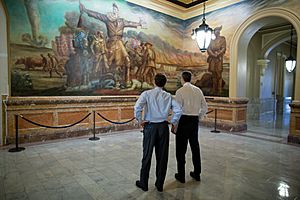
In the 1930s, artist John Steuart Curry painted murals on the second floor. His most famous painting there is called Tragic Prelude. It shows a very large and powerful John Brown caught between the two sides of the American Civil War, with fire and a tornado around him. Curry's art was well-known for showing important, sometimes difficult, parts of Kansas history. He didn't sign his works and didn't finish all the murals he was asked to paint in the rotunda. John Brown was a person who faced serious legal charges, and this painting is believed to be the only time someone like him is shown in a state capitol.
Between 1951 and 1953, David Hicks Overmyer painted a series of murals on the first floor of the rotunda. These paintings show important moments in Kansas history, such as "The Coming of the Spaniards," "The Battle of Arickaree," "The Battle of Mine Creek," "Building a Sod House," "Lewis and Clark in Kansas," "Westward Ho," "Arrival of the Railroad," and "Chisholm Trail."
Later, from 1976 to 1978, Lumen Martin Winter also painted murals in the rotunda.
See also
 In Spanish: Capitolio del Estado de Kansas para niños
In Spanish: Capitolio del Estado de Kansas para niños
- List of Kansas state legislatures
- Kansas Museum of History
- List of state and territorial capitols in the United States
- List of tallest domes


